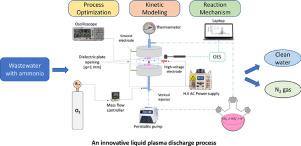Water Research ( IF 11.4 ) Pub Date : 2022-09-13 , DOI: 10.1016/j.watres.2022.119107 Robinson Junior Ndeddy Aka 1 , Sarah Wu 2 , Dinithi Mohotti 1 , Muhammad Aamir Bashir 3 , Alia Nasir 2

|
Removing ammonia-nitrogen (NH3 N) from wastewater is of paramount importance for wastewater treatment. In this study, a novel continuous liquid plasma process (CLPD) was evaluated to remove NH3
N) from wastewater is of paramount importance for wastewater treatment. In this study, a novel continuous liquid plasma process (CLPD) was evaluated to remove NH3 N from synthetic wastewater. The Box–Behnken experimental design was used to optimize the main process parameters, including the initial NH3
N from synthetic wastewater. The Box–Behnken experimental design was used to optimize the main process parameters, including the initial NH3 N concentration (50–200 mg/L), power input (150–300 W), and gas-flow rate (1.5–2.5 L/min), for efficient NH3
N concentration (50–200 mg/L), power input (150–300 W), and gas-flow rate (1.5–2.5 L/min), for efficient NH3 N removal from wastewater. The gas-flow rate and power input were found to be significant factors affecting the removal efficiency of NH3
N removal from wastewater. The gas-flow rate and power input were found to be significant factors affecting the removal efficiency of NH3 N, whereas the initial concentration of NH3
N, whereas the initial concentration of NH3 N played a vital role in determining the energy efficiency of the process. Under the optimal conditions of an initial NH3
N played a vital role in determining the energy efficiency of the process. Under the optimal conditions of an initial NH3 N concentration of 200 mg/L, applied power of 223 W, and gas-flow rate of 2.4 L/min, 98.91% of NH3
N concentration of 200 mg/L, applied power of 223 W, and gas-flow rate of 2.4 L/min, 98.91% of NH3 N could be removed with a N2 selectivity of 92.91%, and the corresponding energy efficiency was 0.527 g/kWh after 2 hrs of treatment. A small fraction of undesirable NO3−-N (7.05 mg/L) and NO2−-N (2.83 mg/L) were also produced. Kinetic modeling revealed that NH3
N could be removed with a N2 selectivity of 92.91%, and the corresponding energy efficiency was 0.527 g/kWh after 2 hrs of treatment. A small fraction of undesirable NO3−-N (7.05 mg/L) and NO2−-N (2.83 mg/L) were also produced. Kinetic modeling revealed that NH3 N degradation by the CLPD followed a pseudo-first-order reaction model, with a rate constant (k) of 0.03522 min−1. Optical emission spectroscopy (OES) was used to gather information about the active chemical species produced during the plasma discharge. The obtained spectra revealed the presence of several highly oxidative radicals, including ‧OH, ‧O, and ‧O2+. These results demonstrate the potential of liquid phase plasma discharge as a highly efficient technology for removing ammonia from aqueous solutions.
N degradation by the CLPD followed a pseudo-first-order reaction model, with a rate constant (k) of 0.03522 min−1. Optical emission spectroscopy (OES) was used to gather information about the active chemical species produced during the plasma discharge. The obtained spectra revealed the presence of several highly oxidative radicals, including ‧OH, ‧O, and ‧O2+. These results demonstrate the potential of liquid phase plasma discharge as a highly efficient technology for removing ammonia from aqueous solutions.
中文翻译:

废水中氨氧化液相等离子体放电工艺的评价:工艺优化和动力学建模
从废水中去除氨氮(NH 3 N)对于废水处理至关重要。在这项研究中,评估了一种新型连续液体等离子体工艺 (CLPD) 从合成废水中去除 NH 3
N)对于废水处理至关重要。在这项研究中,评估了一种新型连续液体等离子体工艺 (CLPD) 从合成废水中去除 NH 3 N。Box-Behnken 实验设计用于优化主要工艺参数,包括初始 NH 3
N。Box-Behnken 实验设计用于优化主要工艺参数,包括初始 NH 3 N 浓度(50-200 mg/L)、功率输入(150-300 W)和气体流速(1.5-2.5 L) /min),用于从废水中有效去除 NH 3
N 浓度(50-200 mg/L)、功率输入(150-300 W)和气体流速(1.5-2.5 L) /min),用于从废水中有效去除 NH 3 N。发现气体流量和功率输入是影响 NH 3 N 去除效率的重要因素,而 NH
N。发现气体流量和功率输入是影响 NH 3 N 去除效率的重要因素,而 NH  3的初始浓度
3的初始浓度 N 在确定过程的能源效率方面发挥了至关重要的作用。在初始NH 3
N 在确定过程的能源效率方面发挥了至关重要的作用。在初始NH 3 N浓度为200 mg/L、外加功率为223 W、气体流量为2.4 L/min的最佳条件下,可去除98.91%的NH 3 N,N
N浓度为200 mg/L、外加功率为223 W、气体流量为2.4 L/min的最佳条件下,可去除98.91%的NH 3 N,N  2选择性为92.91 %,处理 2 小时后相应的能量效率为 0.527 g/kWh。还产生了一小部分不希望的 NO 3 - -N (7.05 mg/L) 和 NO 2 - -N (2.83 mg/L)。动力学模型显示,CLPD对NH 3
2选择性为92.91 %,处理 2 小时后相应的能量效率为 0.527 g/kWh。还产生了一小部分不希望的 NO 3 - -N (7.05 mg/L) 和 NO 2 - -N (2.83 mg/L)。动力学模型显示,CLPD对NH 3 N的降解遵循准一级反应模型,速率常数(k)为0.03522 min -1. 发射光谱 (OES) 用于收集有关等离子体放电过程中产生的活性化学物质的信息。获得的光谱表明存在几种高氧化自由基,包括‧OH、‧O和‧O 2 + 。这些结果证明了液相等离子体放电作为一种从水溶液中去除氨的高效技术的潜力。
N的降解遵循准一级反应模型,速率常数(k)为0.03522 min -1. 发射光谱 (OES) 用于收集有关等离子体放电过程中产生的活性化学物质的信息。获得的光谱表明存在几种高氧化自由基,包括‧OH、‧O和‧O 2 + 。这些结果证明了液相等离子体放电作为一种从水溶液中去除氨的高效技术的潜力。











































 京公网安备 11010802027423号
京公网安备 11010802027423号